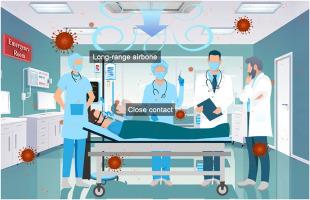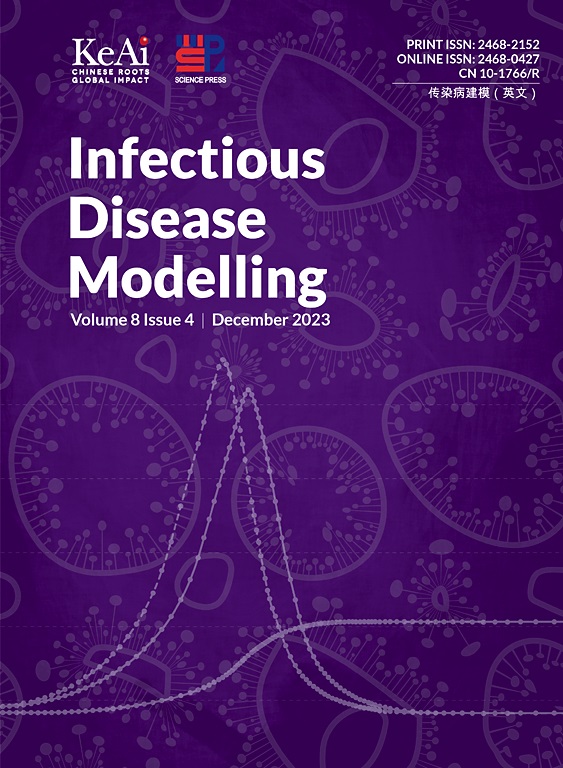基于急诊室真实近距离接触行为的呼吸道传染病传播
IF 2.5
3区 医学
Q1 Medicine
引用次数: 0
摘要
背景:呼吸道传染病在急诊室传播的风险很高,对医护人员的健康构成严重威胁。方法在香港某大学医学院的急诊室进行临床技能竞赛。共采集视频监控数据19246 s,记录了3类患者(P1:输液患者、P2:危重患者、P3:躁动患者)的治疗情况。以2019冠状病毒病(COVID-19)为例,建立多途径传播模型,评估卫生保健工作者的感染风险和各种干预措施的有效性。结果在P1、P2和P3治疗期间,医护人员与患者的平均距离分别为0.8(25-75个百分点:0.6、1.1)m、1.0(0.8、1.2)m和0.5(0.4、0.7)m。在治疗P2时,由于插管手术,如果医护人员不戴口罩,每小时感染风险最高,为43.4%,分别是治疗P1(8.5%)和P3(13.9%)时的5.1和3.1倍。治疗期间,未戴口罩的护士平均小时感染风险分别为11.0% (P1)、41.2% (P2)和16.8% (P3),分别是医生的1.8倍(P1)、0.9倍(P2)和1.5倍(P3)。如果医护人员全程佩戴N95口罩和医用口罩,总感染风险分别降低94.7%和53.9%。将通气量从1 ACH增加到6 ACH,通过空气传播的感染风险分别降低43.8% (P1)、36.1% (P2)和31.6% (P3),总感染风险分别降低2.4% (P1)、5.6% (P2)和1.6% (P3)。结论本研究结果为急诊室不同治疗方式下呼吸道传染病的精准防控提供了科学依据。本文章由计算机程序翻译,如有差异,请以英文原文为准。

Transmission of respiratory infectious diseases based on real close contact behavior in an emergency room
Background
The risk of transmission of respiratory infectious diseases in emergency rooms is high, posing a severe threat to the health of healthcare workers (HCWs).
Methods
The study was conducted in an emergency room of a medical school at a university in Hong Kong during a clinical skills competition. A total of 19,246 s of video surveillance data were collected, recording the treatment of three types of patients (P1: infusion patient, P2: critically ill patient, P3: agitated patient). Taking coronavirus disease 2019 (COVID-19) as an example, a multi-route transmission model was established to assess the infection risk for HCWs and the effectiveness of various interventions.
Results
The average distances between HCWs and patients during the treatment of P1, P2, and P3 were 0.8 (25–75 percentile: 0.6, 1.1) m, 1.0 (0.8, 1.2) m, and 0.5 (0.4, 0.7) m, respectively. When treating P2, due to intubation procedures, the hourly risk of infection was highest at 43.4 % if no HCWs wore masks, which was 5.1 and 3.1 times higher than it during treatment of P1 (8.5 %) and P3 (13.9 %), respectively. During the treatment, without mask protection, the average hourly infection risk for nurses was 11.0 % (P1), 41.2 % (P2), and 16.8 % (P3), which was 1.8 times (P1), 0.9 times (P2), and 1.5 times (P3) that of doctors. If HCWs wear N95 respirators and surgical masks throughout, the total infection risk can be reduced by 94.7 % and 53.9 %, respectively. Increasing the ventilation rate from 1 ACH to 6 ACH reduced the infection risk through long-range airborne transmission by 43.8 % (P1), 36.1 % (P2), and 31.6 % (P3), with a total infection risk reduction of 2.4 % (P1), 5.6 % (P2), and 1.6 % (P3), respectively.
Conclusions
The findings of the study provide a scientific support for the precise prevention and control of respiratory infectious diseases under different treatments in emergency rooms.
求助全文
通过发布文献求助,成功后即可免费获取论文全文。
去求助
来源期刊

Infectious Disease Modelling
Mathematics-Applied Mathematics
CiteScore
17.00
自引率
3.40%
发文量
73
审稿时长
17 weeks
期刊介绍:
Infectious Disease Modelling is an open access journal that undergoes peer-review. Its main objective is to facilitate research that combines mathematical modelling, retrieval and analysis of infection disease data, and public health decision support. The journal actively encourages original research that improves this interface, as well as review articles that highlight innovative methodologies relevant to data collection, informatics, and policy making in the field of public health.
 求助内容:
求助内容: 应助结果提醒方式:
应助结果提醒方式:


